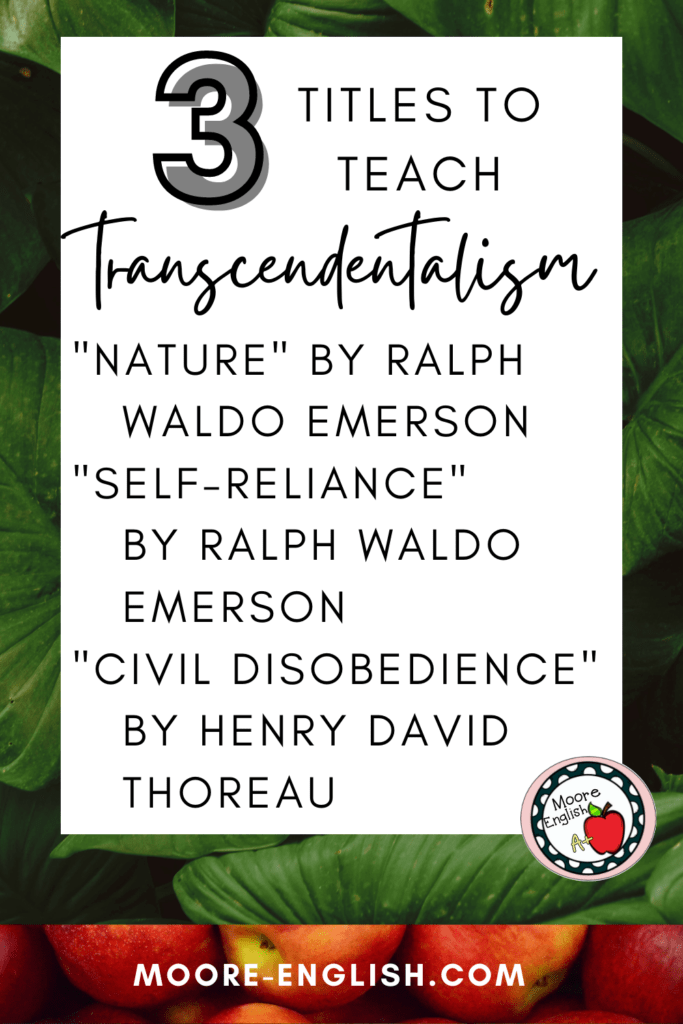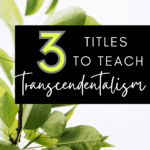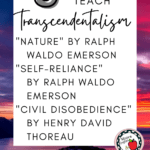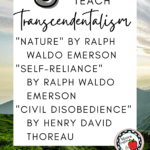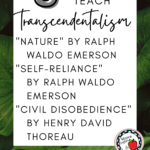A unit about Transcendentalism is a staple in many American literature classes. As a result, lessons about Transcendentalism can sometimes feel a little stale. It’s hard to get students excited about a literary movement that started before the Civil War. For this reason, I have worked hard to develop lessons that help students appreciate the relevance of Transcendentalism.
Since Transcendentalism was such a short-lived literary period (although it has its legacy), I don’t spend too much time with this unit. At its shortest, this can be a two-week unit. At its longest, this can be a month-long unit. Grab my complete, free unit planner today!
This post this post may contain affiliate links. Please read the Terms of Use.
Introducing Transcendentalism
Anticipation guides are one of my favorite ways to introduce a new unit. For Transcendentalism, I use this anticipation guide. Students complete the anticipation guide individually, which takes 5-10 minutes. Then, students find a partner and discuss the first row of the anticipation guide for 1-2 minutes. Students then rotate to a second partner to discuss the second row. We complete this movement until students have discussed each row of the anticipation guide. This lesson design is a great way to incorporate classroom movement, build classroom community, and generate excitement!
Similarly, during our study of Transcendentalism, I often use these journal prompts as bell work. Journals are one of my favorite ways to help students process new material, build connections, and revisit essential questions.
Transcendentalism Text Selections
Since this is a fairly short unit for me, I usually only cover a few texts. In particular, I enjoy using this acronym to help students process the different characteristics of Transcendentalism. Students can match each characteristic to each text that we encounter.
First, I often begin with an excerpt from “Nature” by Ralph Waldo Emerson. As the founder of Transcendentalism, Emerson’s work is a good place to begin. This text also clearly shows the relationship between Transcendentalism and Romanticism. Furthermore, this is a good text to start with because the speaker’s purpose is clear and unambiguous. Read it here.
Second, students move to an excerpt from “Self-Reliance” by Ralph Waldo Emerson. As a scaffold upward, this text is more challenging than “Nature.” Emerson’s argument has more layers, and his purpose is more complex. However, his argument is clearly relevant to students. To scaffold this lesson, we usually work in a cycle of gradual release. Read it here.
Then, we study “Civil Disobedience” by Henry David Thoreau. While Walden is, perhaps, Thoreau’s most-famous work, it retreads ground covered by “Nature,” so I prefer this essay. Additionally, this essay rings true with students’ increasing interests in activism. As social justice becomes a greater focus for students, this essay becomes increasingly relevant for students. Read it here.
If there’s additional time, Walt Whitman was open about the influence of the Transcendentalists on his work. With this in mind, students can explore Whitman’s poetry to see that influence at work. In particular, “When I Heard the Learn’d Astronomer” and “Song of Myself” are clear demonstrations of this connection. Read them here.
Activities for Exploring Transcendentalism
In addition to reading and annotating these texts, there are several engaging activities that can help make the most of this unit.
- First, students can develop their own slogans, t-shirts, or bumper stickers to reflect their own views. These can be drawn from the texts, inspired by current events, or written for modern-day Transcendentalists. I’ve used the t-shirt strategy several times, and students love sharing their work with one another.
- In the spirit of “Civil Disobedience,” students can try their hand at writing letters to their congressional representatives. Using one of these letter-writing rubrics, students can write formal, persuasive letters in which they express their thoughts about world issues. If students are not interested in letter writing, they can also try writing newspaper editorials.
- Finally, students can try writing their own Transcendentalist-inspired poetry like Walt Whitman. Students can use “I Hear America Singing” or “America” as templates for writing their own poems. Students can then share their poems and/or color-code their choices to signal which elements of Transcendentalism they are emphasizing.
Save yourself some time by grabbing the Transcendentalism Bundle today!

